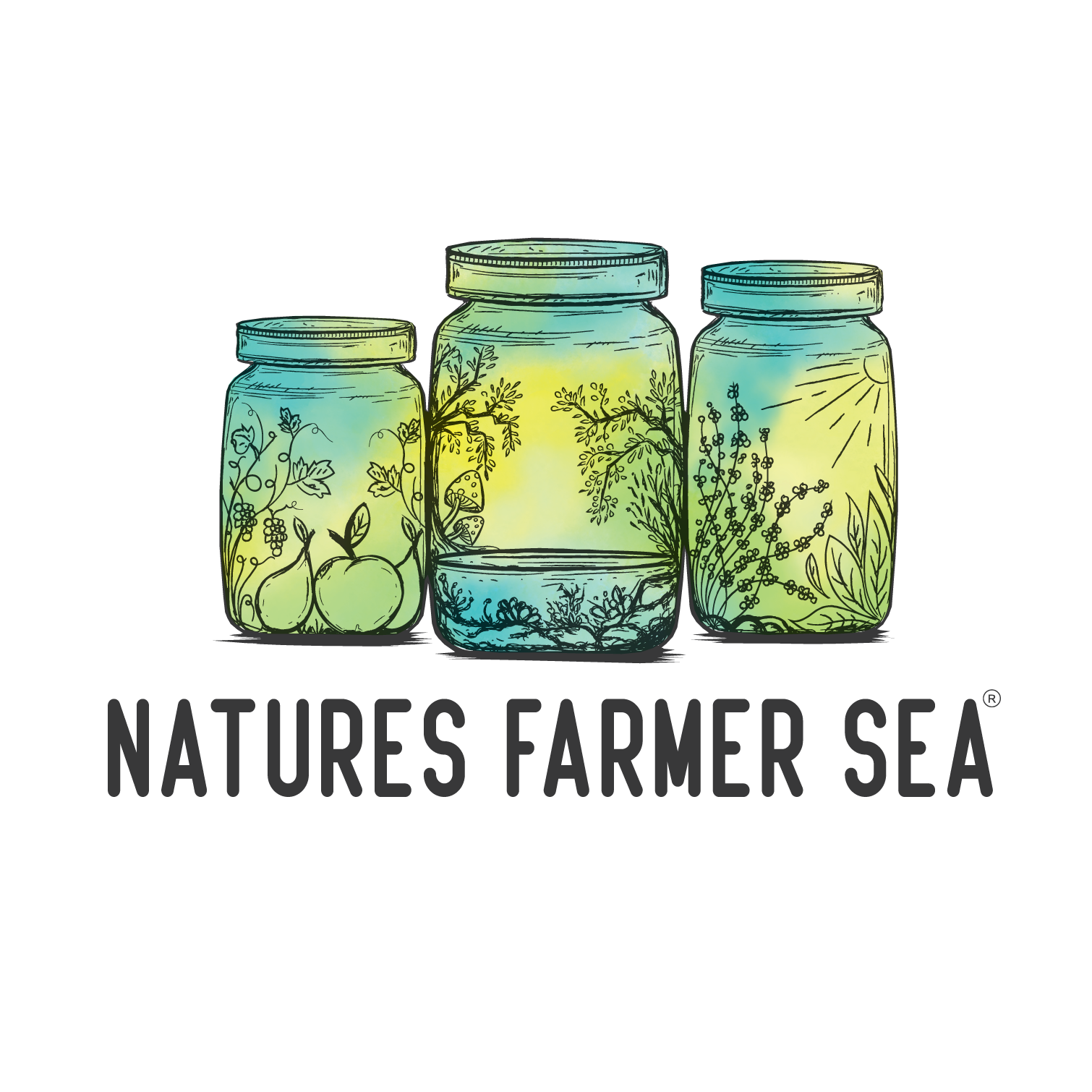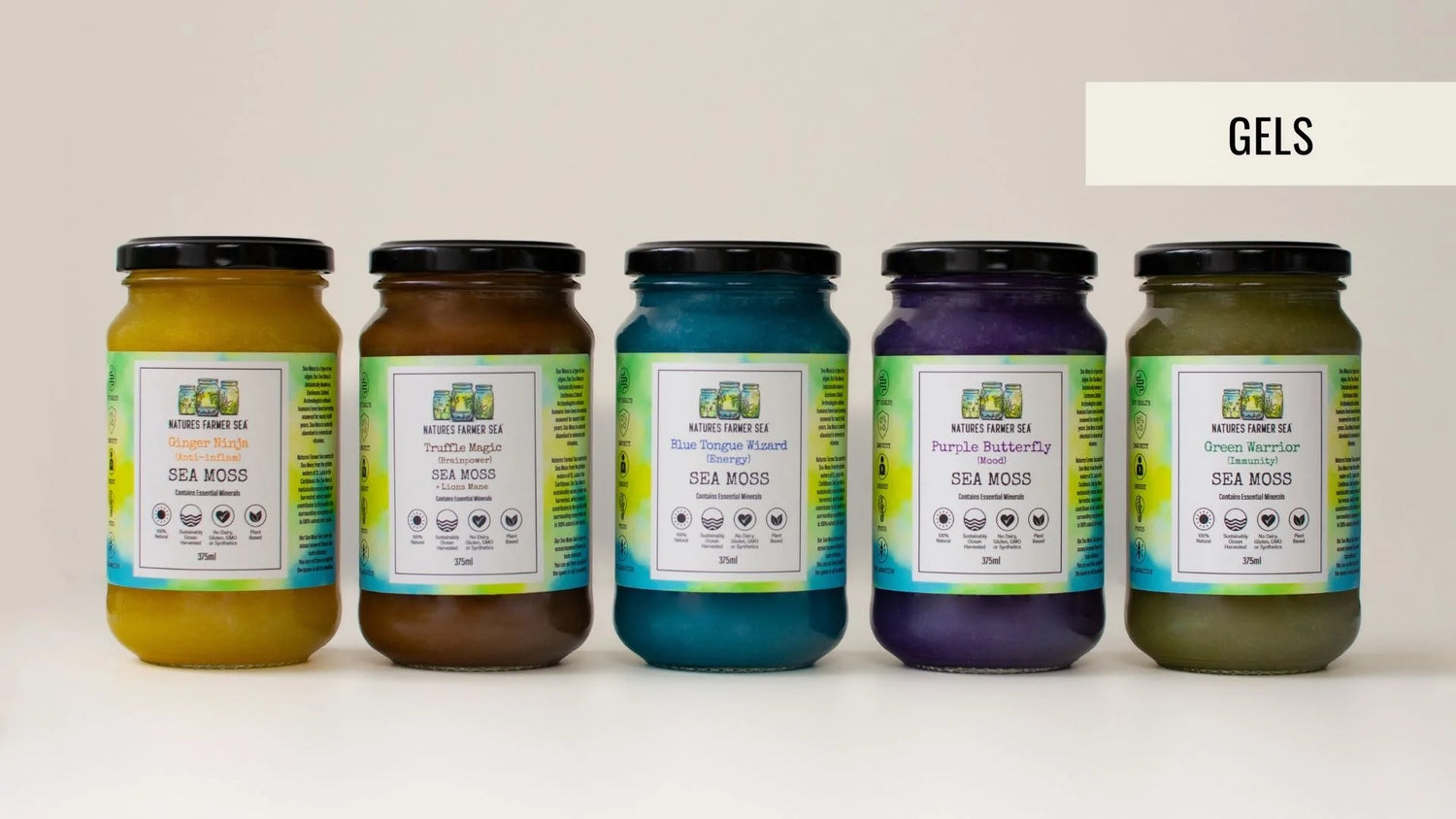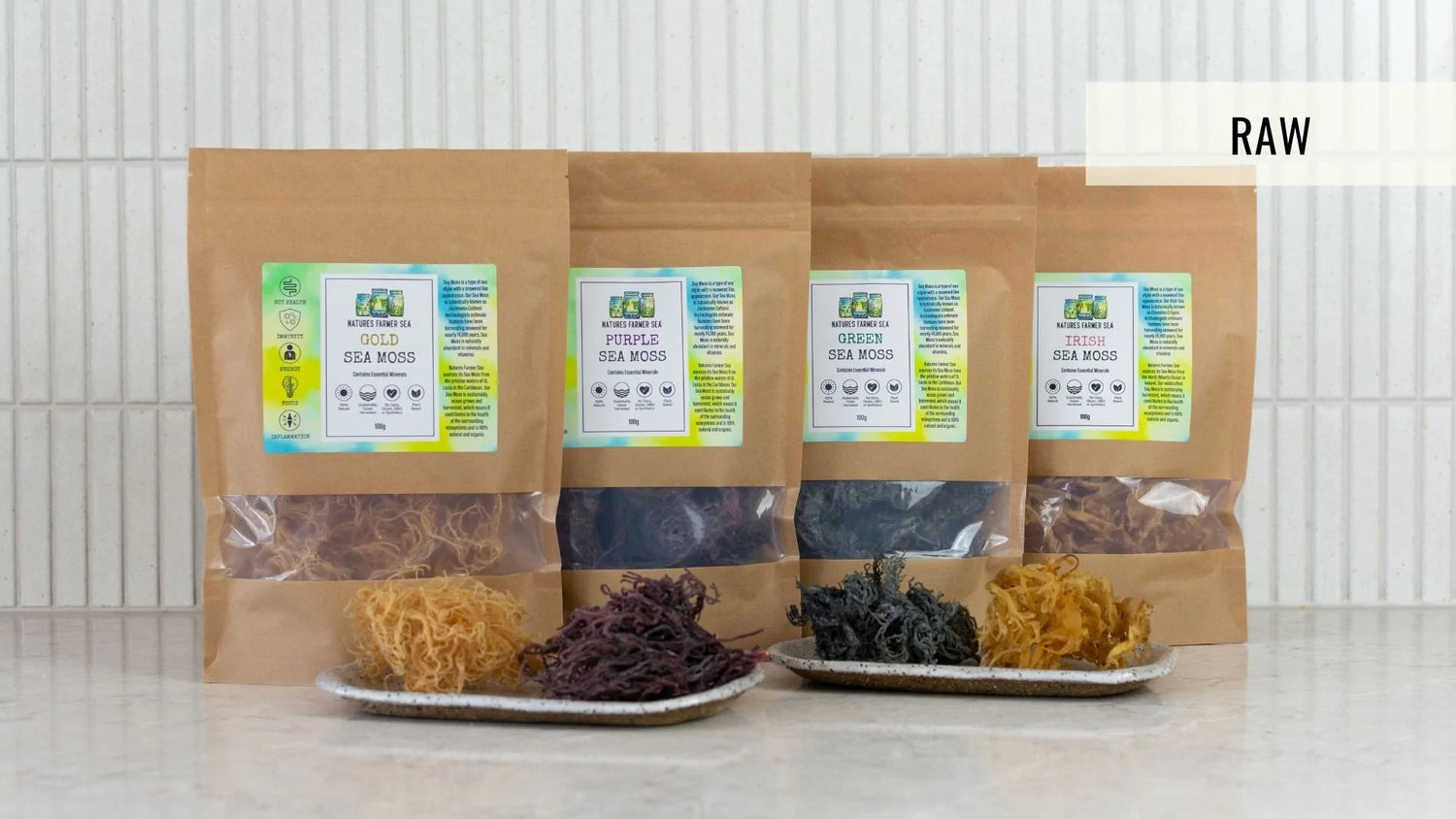
Carrageenan Vs Poligeenan
Carrageenan vs. Poligeenan: Understanding the Difference Through Science
By Lillian Jessop
Bachelor Marine Science (Oceanography), Dip. Health Science (Nat)
Our sea moss gels are crafted from Eucheuma Cottonii, a red seaweed known for its extensive health benefits. Among its primary bioactive components is carrageenan, a sulfated polysaccharide renowned for its numerous applications in the food industry. However, confusion has arisen around its safety due to misidentification with poligeenan—a chemically altered derivative—and degraded carrageenan. This blog delves into the scientific distinctions between these substances, clarifying their roles, applications, and safety profiles.
What is Carrageenan?
Carrageenan is a natural polysaccharide extracted from red seaweed, including E. Cottonii, through a gentle alkaline process. It is composed of sulfated galactose units, forming helical molecular structures that provide gelling, stabilising, and thickening properties.
• The predominant type in E. Cottonii is kappa-carrageenan, known for its ability to form strong, elastic gels when combined with potassium salts (EFSA Panel on Food Additives and Nutrient Sources, 2018).
• Once consumed, carrageenan remains structurally intact due to its high molecular weight (200,000 to 800,000 Daltons), which ensures it is excreted unchanged and does not interfere with metabolic processes (Weiner, 2014).
What is Poligeenan?
Poligeenan, by contrast, is a chemically degraded form of carrageenan. It is not naturally occurring but is produced through a controlled chemical process involving:
• Low pH (0.9–1.3)
• High temperatures (exceeding 80°C for several hours)
These conditions fragment carrageenan’s molecular structure, reducing its molecular weight to 10,000–20,000 Daltons (McKim et al., 2019). Unlike carrageenan, poligeenan:
• Lacks structural integrity and functional properties, making it unsuitable for food applications.
• Is primarily used in industrial and medical settings (e.g., as a thickening agent in barium sulfate solutions for X-ray imaging).
• Is not approved by regulatory bodies like the FDA and EFSA for food use due to its potential to induce inflammatory effects.

Figure 1: Comparing the molecular weight of poligeenan and carrageenan. The molecular weight profile graph clearly shows the significant difference between carrageenan (200,000–800,000 Da) and poligeenan (10,000–20,000 Da). This highlights the structural integrity of carrageenan as a safe food additive while distinguishing it from poligeenan (McKim et al., 2019).
The Debate: Carrageenan vs. Poligeenan
The debate surrounding carrageenan’s safety arises from confusion in scientific terminology. Early studies often failed to distinguish between food-grade carrageenan and poligeenan, using terms like “degraded carrageenan” interchangeably with “carrageenan.”
• Poligeenan’s Risks: Poligeenan can penetrate biological tissues and potentially induce inflammation or carcinogenic effects due to its low molecular weight and fragmented structure.
• Carrageenan’s Safety: Food-grade carrageenan retains its high molecular weight and helical integrity, ensuring it does not interact with tissues in the same way (McKim et al., 2019).
Modern toxicological research reaffirms the safety of food-grade carrageenan when used as intended.
What Are Each Used For?
Carrageenan
• Food Applications:
• Stabilizing and thickening in dairy products (e.g., ice cream, yogurts, plant-based milk)
• Processed meats (improves water retention and texture)
Cosmetics:
• Enhancing viscosity and consistency in creams and lotions (EFSA Panel on Food Additives and Nutrient Sources, 2018).
Poligeenan
-
Industrial and Medical Applications:
• Thickening agent in barium sulphate mixtures for X-ray imaging (McKim et al., 2019).
• Restrictions: Due to its lack of structural stability and low molecular weight, poligeenan is unsafe for ingestion.
Scientific Evidence on Safety
• Carrageenan’s Safety: Supported by extensive toxicological studies and regulatory reviews from organisations like:
• The Joint FAO/WHO Expert Committee on Food Additives (JECFA)
• The European Food Safety Authority (EFSA)
• Carrageenan is not absorbed, metabolised, or associated with carcinogenicity when used as intended (EFSA Panel on Food Additives and Nutrient Sources, 2018).
• Poligeenan’s Risks: Animal studies show poligeenan can induce inflammatory effects due to its low molecular weight and tissue-penetrating properties. This reinforces the importance of distinguishing between the two substances (Weiner, 2014).
Conclusion
Through precise scientific distinctions, it becomes evident that carrageenan and poligeenan are vastly different substances:
• Carrageenan, derived from red seaweed like E. cottonii, is a safe and functional ingredient for food and cosmetic applications.
• Poligeenan, a chemically altered derivative, serves entirely different industrial and medical purposes and is not approved for food use.
By focusing on high-quality, whole-form sea moss gels, our products harness the natural benefits of carrageenan, providing consumers with safe and health-promoting options. The scientific clarity behind these substances reaffirms carrageenan’s place as a valuable and safe food ingredient.
FAQS:
1. Can carrageenan cause digestive issues?
Answer: Some studies suggest that carrageenan may cause digestive discomfort in certain individuals, potentially leading to inflammation or gastrointestinal issues.
However, more research is needed to establish a definitive link.
2. Is carrageenan suitable for vegans and vegetarians?
Answer: Yes, carrageenan is derived from red seaweed, making it a plant-based ingredient suitable for both vegans and vegetarians. It’s commonly used as a gelling agent in vegan and vegetarian food products.
3. How can consumers identify products containing carrageenan?
Answer: Consumers can identify products containing carrageenan by checking the ingredient list on food labels. It is often listed as ‘carrageenan’ or by its food additive code ‘E407’.
4. Are there any regulatory limits on carrageenan use in foods?
Answer: Yes, regulatory bodies such as the U.S. Food and Drug Administration (FDA) and the European Food Safety Authority (EFSA) have established guidelines to ensure the safe use of carrageenan in food products.
5. Can carrageenan be used in homemade recipes?
Answer: Yes, carrageenan can be used in homemade recipes as a thickening or gelling agent. It is available for purchase in various forms suitable for culinary use.
References
EFSA Panel on Food Additives and Nutrient Sources added to Food. (2018). Re-evaluation of carrageenan (E 407) and processed Eucheuma seaweed (E 407a) as food additives. EFSA Journal, 16(4), 5238. https://doi.org/10.2903/j.efsa.2018.5238
McKim, J. M., Willoughby, J. A., Blakemore, W. R., & Weiner, M. L. (2019). Clarifying the confusion between poligeenan, degraded carrageenan, and carrageenan: A review of the chemistry, nomenclature, and in vivo toxicology. Critical Reviews in Food Science and Nutrition, 59(19), 3054–3073. https://doi.org/10.1080/10408398.2018.1481822
Weiner, M. L. (2014). Food additive carrageenan: Part II: A critical review of carrageenan in vivo safety studies. Critical Reviews in Toxicology, 44(3), 244–269. https://doi.org/10.3109/10408444.2013.861798



